Business Economics Assignment: GDP, Inflation, and Unemployment
VerifiedAdded on 2020/05/04
|22
|3153
|90
Homework Assignment
AI Summary
This assignment provides a comprehensive analysis of various macroeconomic concepts. It begins with the calculation of GDP using both the income and expenditure methods, followed by the analysis of Gross National Expenditure (GNE), Net Domestic Product (NDP), Gross National Product (GNP), and Net National Product (NNP). The assignment then delves into the current account balance and gross national savings, including the impact of marginal propensity to consume on domestic consumption. Further sections analyze the difference between intermediate and final goods, cost-push and demand-pull inflation, and the role of macroeconomic policy in addressing unemployment. The assignment also discusses the impact of various economic scenarios, such as changes in marketing activity, import levels, capital stock destruction, and personal income tax, on aggregate demand and GDP. Finally, it covers the advantages and disadvantages of using the Consumer Price Index (CPI) and the differing effects of price increases on various groups, as well as the accuracy of unemployment measures.
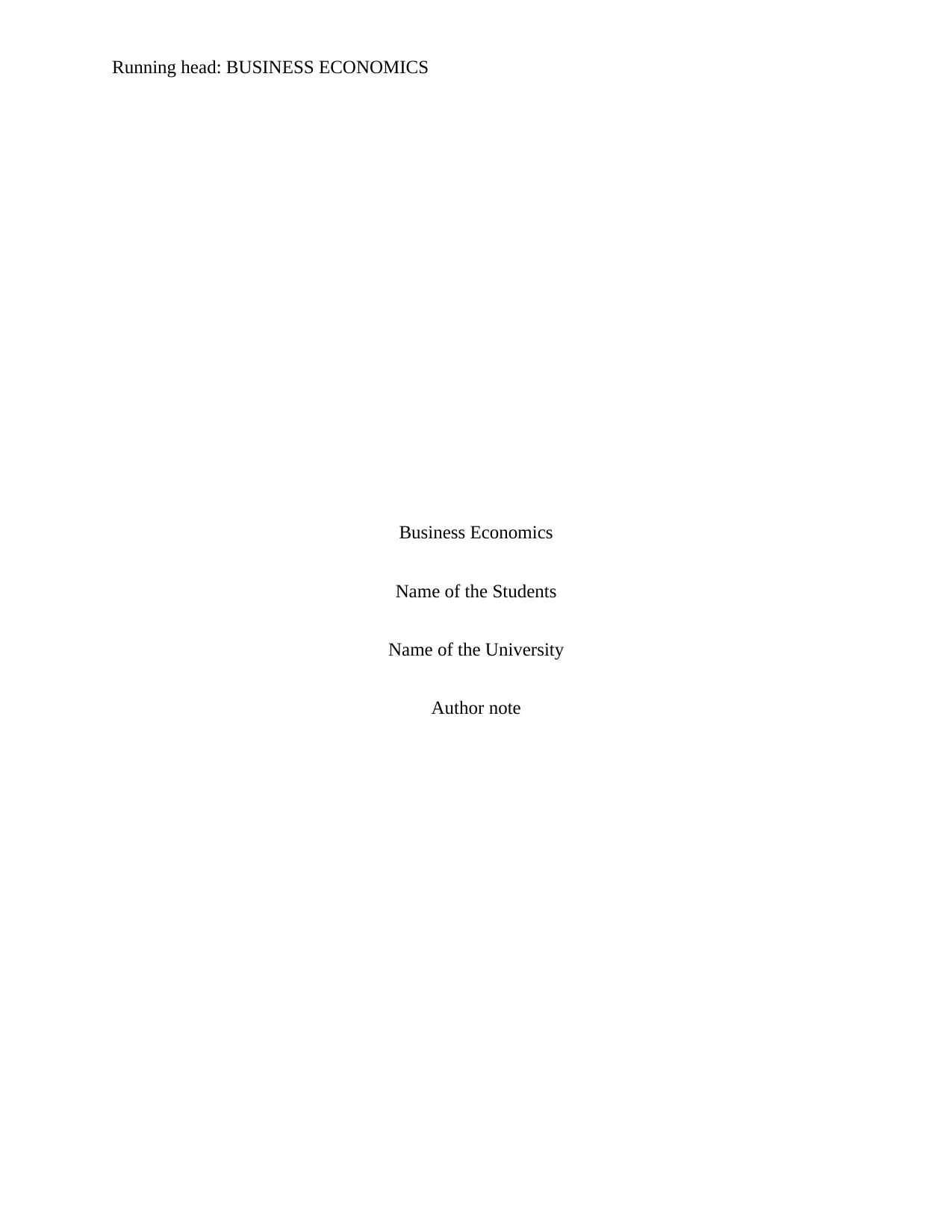
Running head: BUSINESS ECONOMICS
Business Economics
Name of the Students
Name of the University
Author note
Business Economics
Name of the Students
Name of the University
Author note
Paraphrase This Document
Need a fresh take? Get an instant paraphrase of this document with our AI Paraphraser
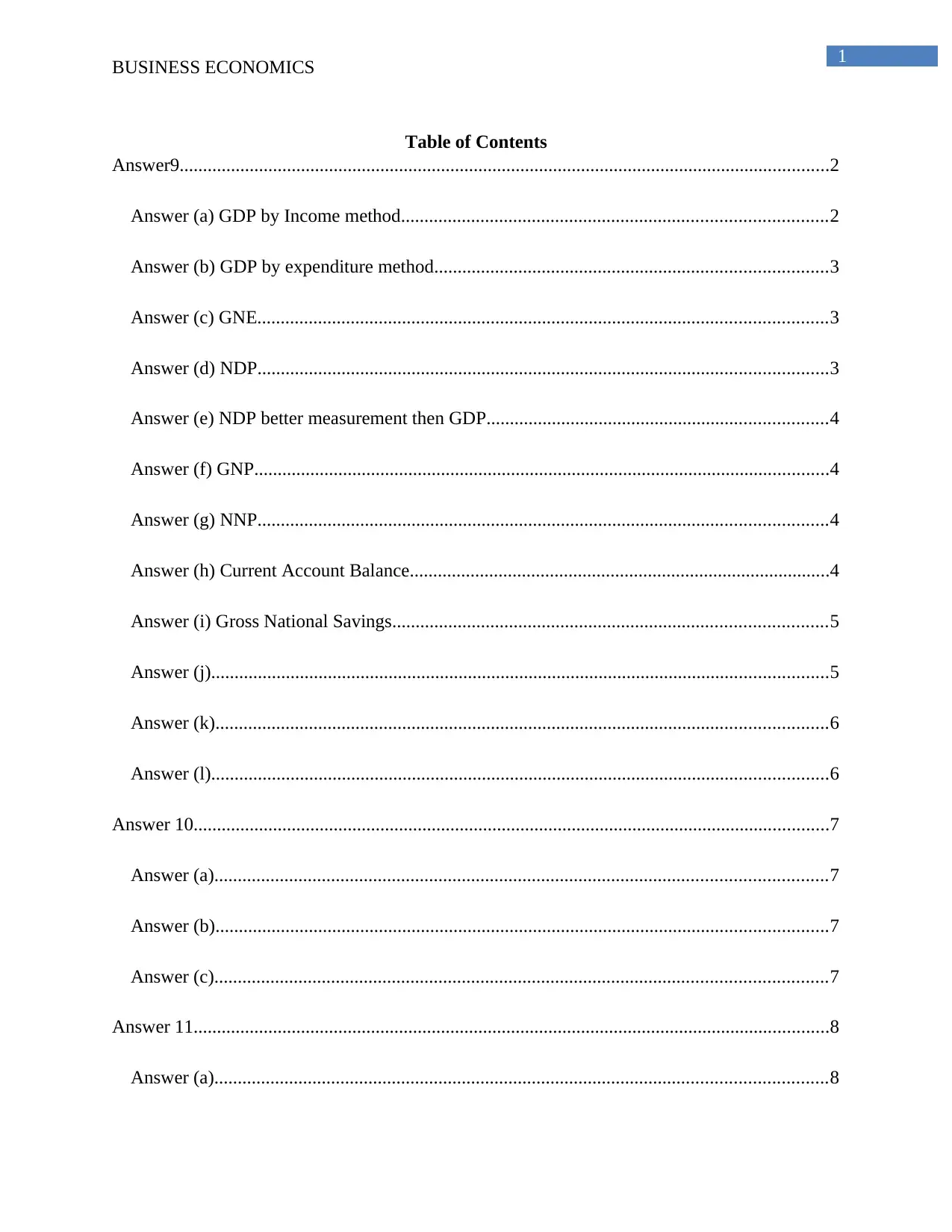
1
BUSINESS ECONOMICS
Table of Contents
Answer9...........................................................................................................................................2
Answer (a) GDP by Income method...........................................................................................2
Answer (b) GDP by expenditure method....................................................................................3
Answer (c) GNE..........................................................................................................................3
Answer (d) NDP..........................................................................................................................3
Answer (e) NDP better measurement then GDP.........................................................................4
Answer (f) GNP...........................................................................................................................4
Answer (g) NNP..........................................................................................................................4
Answer (h) Current Account Balance..........................................................................................4
Answer (i) Gross National Savings.............................................................................................5
Answer (j)....................................................................................................................................5
Answer (k)...................................................................................................................................6
Answer (l)....................................................................................................................................6
Answer 10........................................................................................................................................7
Answer (a)...................................................................................................................................7
Answer (b)...................................................................................................................................7
Answer (c)...................................................................................................................................7
Answer 11........................................................................................................................................8
Answer (a)...................................................................................................................................8
BUSINESS ECONOMICS
Table of Contents
Answer9...........................................................................................................................................2
Answer (a) GDP by Income method...........................................................................................2
Answer (b) GDP by expenditure method....................................................................................3
Answer (c) GNE..........................................................................................................................3
Answer (d) NDP..........................................................................................................................3
Answer (e) NDP better measurement then GDP.........................................................................4
Answer (f) GNP...........................................................................................................................4
Answer (g) NNP..........................................................................................................................4
Answer (h) Current Account Balance..........................................................................................4
Answer (i) Gross National Savings.............................................................................................5
Answer (j)....................................................................................................................................5
Answer (k)...................................................................................................................................6
Answer (l)....................................................................................................................................6
Answer 10........................................................................................................................................7
Answer (a)...................................................................................................................................7
Answer (b)...................................................................................................................................7
Answer (c)...................................................................................................................................7
Answer 11........................................................................................................................................8
Answer (a)...................................................................................................................................8
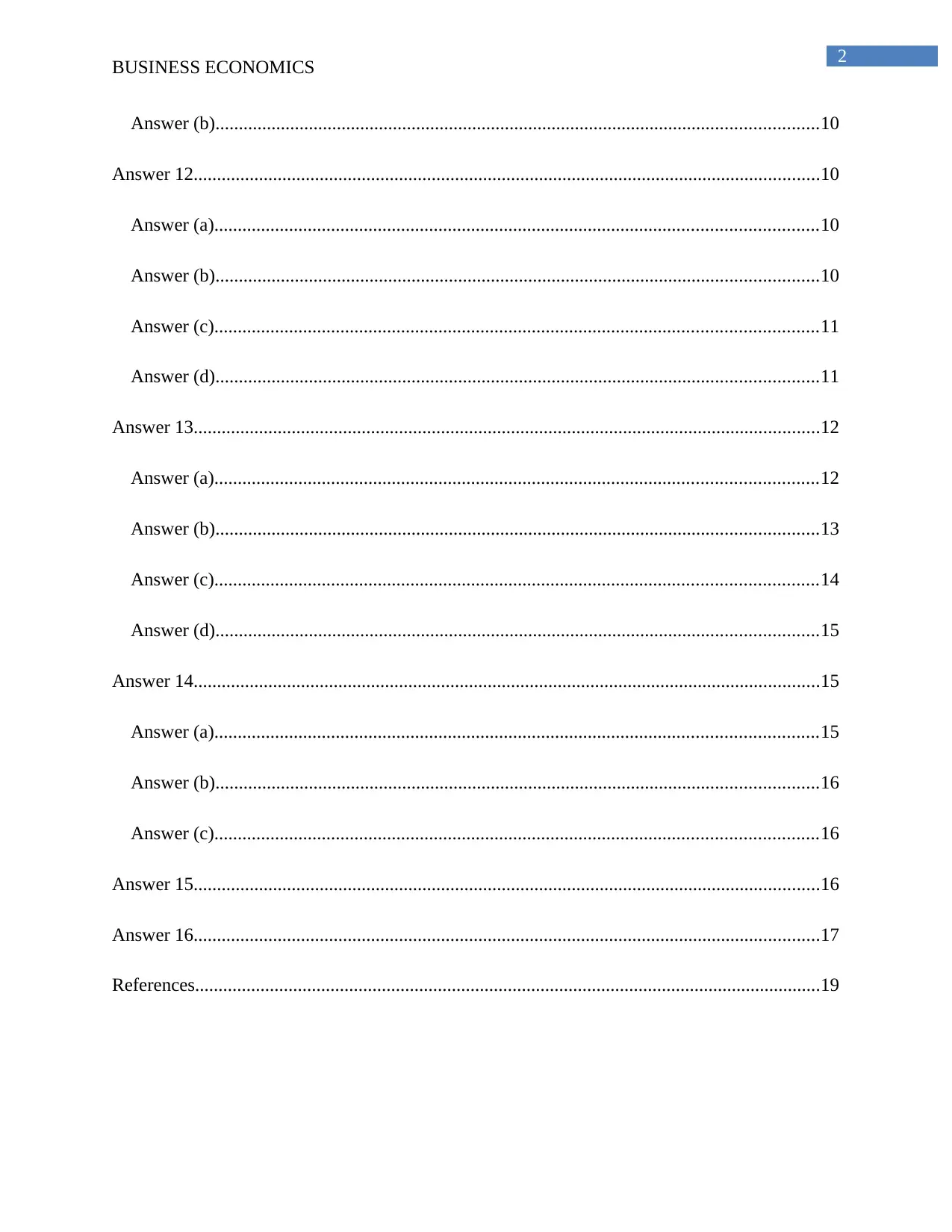
2
BUSINESS ECONOMICS
Answer (b).................................................................................................................................10
Answer 12......................................................................................................................................10
Answer (a).................................................................................................................................10
Answer (b).................................................................................................................................10
Answer (c).................................................................................................................................11
Answer (d).................................................................................................................................11
Answer 13......................................................................................................................................12
Answer (a).................................................................................................................................12
Answer (b).................................................................................................................................13
Answer (c).................................................................................................................................14
Answer (d).................................................................................................................................15
Answer 14......................................................................................................................................15
Answer (a).................................................................................................................................15
Answer (b).................................................................................................................................16
Answer (c).................................................................................................................................16
Answer 15......................................................................................................................................16
Answer 16......................................................................................................................................17
References......................................................................................................................................19
BUSINESS ECONOMICS
Answer (b).................................................................................................................................10
Answer 12......................................................................................................................................10
Answer (a).................................................................................................................................10
Answer (b).................................................................................................................................10
Answer (c).................................................................................................................................11
Answer (d).................................................................................................................................11
Answer 13......................................................................................................................................12
Answer (a).................................................................................................................................12
Answer (b).................................................................................................................................13
Answer (c).................................................................................................................................14
Answer (d).................................................................................................................................15
Answer 14......................................................................................................................................15
Answer (a).................................................................................................................................15
Answer (b).................................................................................................................................16
Answer (c).................................................................................................................................16
Answer 15......................................................................................................................................16
Answer 16......................................................................................................................................17
References......................................................................................................................................19
⊘ This is a preview!⊘
Do you want full access?
Subscribe today to unlock all pages.

Trusted by 1+ million students worldwide
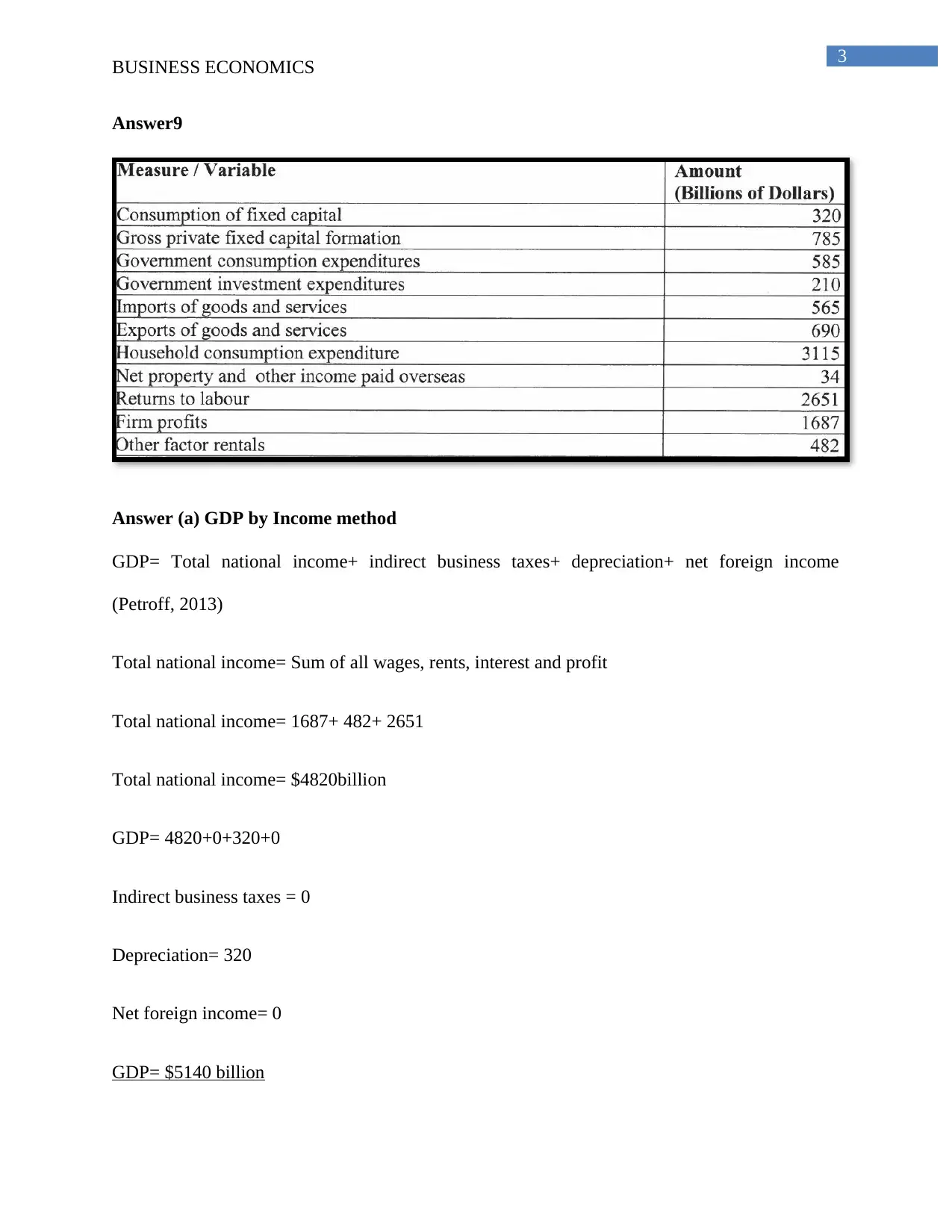
3
BUSINESS ECONOMICS
Answer9
Answer (a) GDP by Income method
GDP= Total national income+ indirect business taxes+ depreciation+ net foreign income
(Petroff, 2013)
Total national income= Sum of all wages, rents, interest and profit
Total national income= 1687+ 482+ 2651
Total national income= $4820billion
GDP= 4820+0+320+0
Indirect business taxes = 0
Depreciation= 320
Net foreign income= 0
GDP= $5140 billion
BUSINESS ECONOMICS
Answer9
Answer (a) GDP by Income method
GDP= Total national income+ indirect business taxes+ depreciation+ net foreign income
(Petroff, 2013)
Total national income= Sum of all wages, rents, interest and profit
Total national income= 1687+ 482+ 2651
Total national income= $4820billion
GDP= 4820+0+320+0
Indirect business taxes = 0
Depreciation= 320
Net foreign income= 0
GDP= $5140 billion
Paraphrase This Document
Need a fresh take? Get an instant paraphrase of this document with our AI Paraphraser
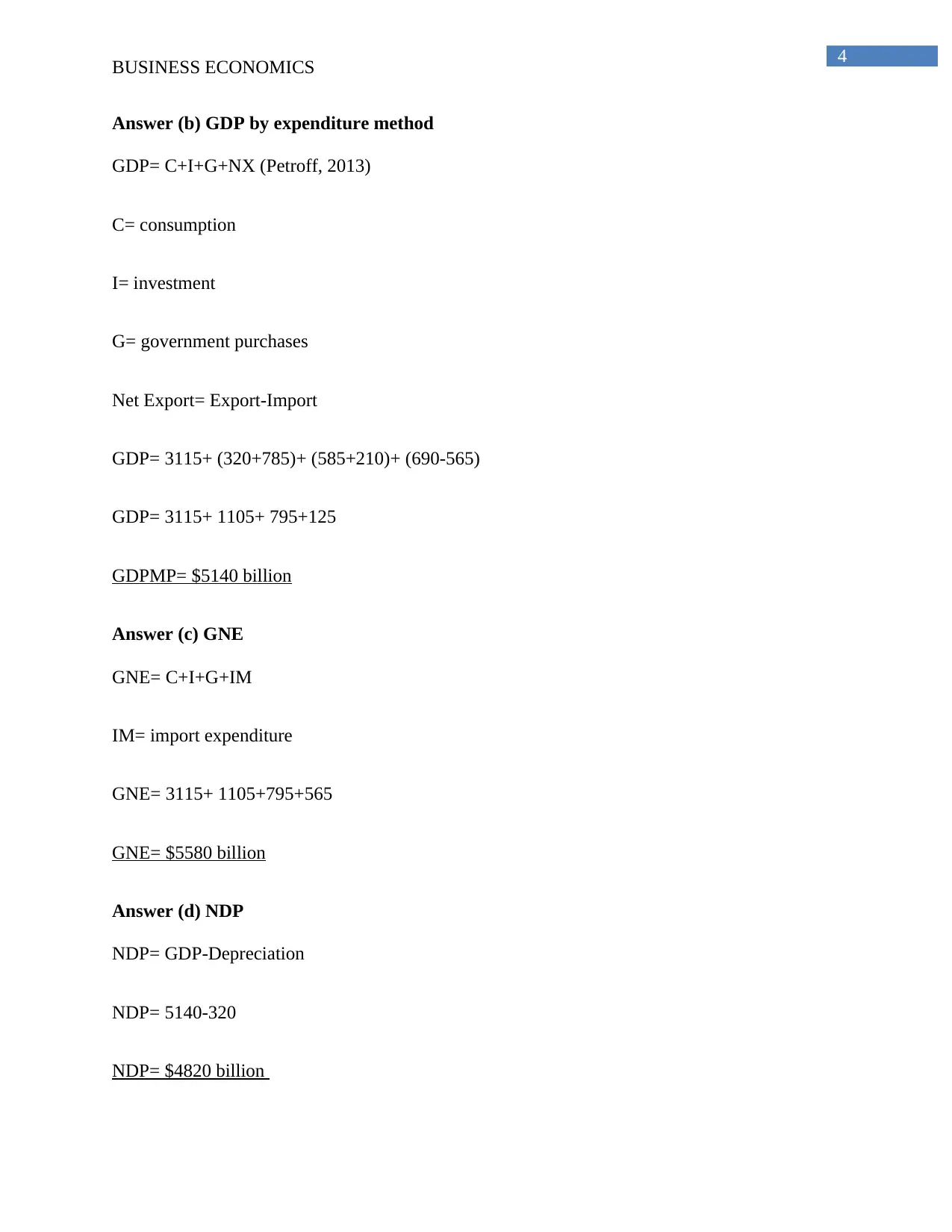
4
BUSINESS ECONOMICS
Answer (b) GDP by expenditure method
GDP= C+I+G+NX (Petroff, 2013)
C= consumption
I= investment
G= government purchases
Net Export= Export-Import
GDP= 3115+ (320+785)+ (585+210)+ (690-565)
GDP= 3115+ 1105+ 795+125
GDPMP= $5140 billion
Answer (c) GNE
GNE= C+I+G+IM
IM= import expenditure
GNE= 3115+ 1105+795+565
GNE= $5580 billion
Answer (d) NDP
NDP= GDP-Depreciation
NDP= 5140-320
NDP= $4820 billion
BUSINESS ECONOMICS
Answer (b) GDP by expenditure method
GDP= C+I+G+NX (Petroff, 2013)
C= consumption
I= investment
G= government purchases
Net Export= Export-Import
GDP= 3115+ (320+785)+ (585+210)+ (690-565)
GDP= 3115+ 1105+ 795+125
GDPMP= $5140 billion
Answer (c) GNE
GNE= C+I+G+IM
IM= import expenditure
GNE= 3115+ 1105+795+565
GNE= $5580 billion
Answer (d) NDP
NDP= GDP-Depreciation
NDP= 5140-320
NDP= $4820 billion
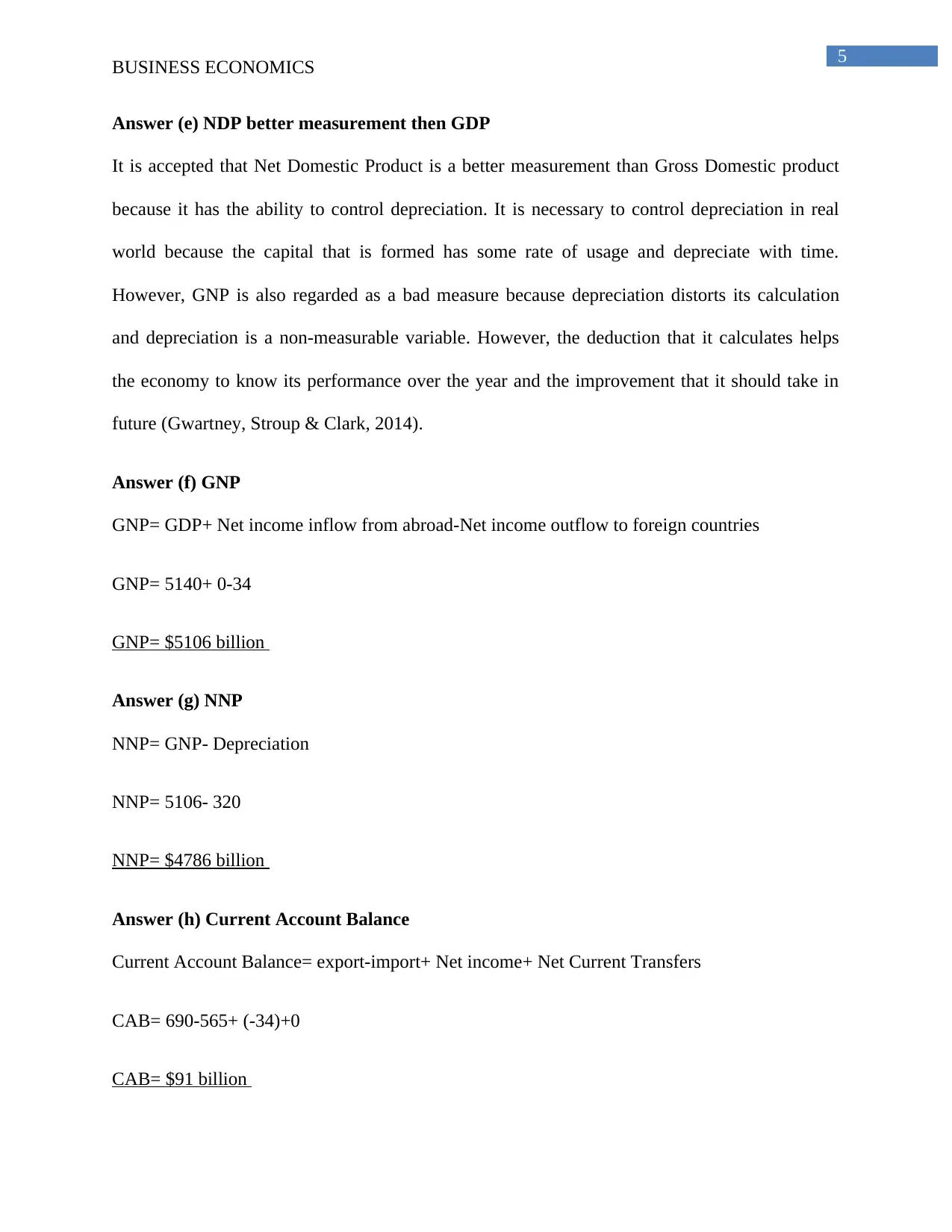
5
BUSINESS ECONOMICS
Answer (e) NDP better measurement then GDP
It is accepted that Net Domestic Product is a better measurement than Gross Domestic product
because it has the ability to control depreciation. It is necessary to control depreciation in real
world because the capital that is formed has some rate of usage and depreciate with time.
However, GNP is also regarded as a bad measure because depreciation distorts its calculation
and depreciation is a non-measurable variable. However, the deduction that it calculates helps
the economy to know its performance over the year and the improvement that it should take in
future (Gwartney, Stroup & Clark, 2014).
Answer (f) GNP
GNP= GDP+ Net income inflow from abroad-Net income outflow to foreign countries
GNP= 5140+ 0-34
GNP= $5106 billion
Answer (g) NNP
NNP= GNP- Depreciation
NNP= 5106- 320
NNP= $4786 billion
Answer (h) Current Account Balance
Current Account Balance= export-import+ Net income+ Net Current Transfers
CAB= 690-565+ (-34)+0
CAB= $91 billion
BUSINESS ECONOMICS
Answer (e) NDP better measurement then GDP
It is accepted that Net Domestic Product is a better measurement than Gross Domestic product
because it has the ability to control depreciation. It is necessary to control depreciation in real
world because the capital that is formed has some rate of usage and depreciate with time.
However, GNP is also regarded as a bad measure because depreciation distorts its calculation
and depreciation is a non-measurable variable. However, the deduction that it calculates helps
the economy to know its performance over the year and the improvement that it should take in
future (Gwartney, Stroup & Clark, 2014).
Answer (f) GNP
GNP= GDP+ Net income inflow from abroad-Net income outflow to foreign countries
GNP= 5140+ 0-34
GNP= $5106 billion
Answer (g) NNP
NNP= GNP- Depreciation
NNP= 5106- 320
NNP= $4786 billion
Answer (h) Current Account Balance
Current Account Balance= export-import+ Net income+ Net Current Transfers
CAB= 690-565+ (-34)+0
CAB= $91 billion
⊘ This is a preview!⊘
Do you want full access?
Subscribe today to unlock all pages.

Trusted by 1+ million students worldwide
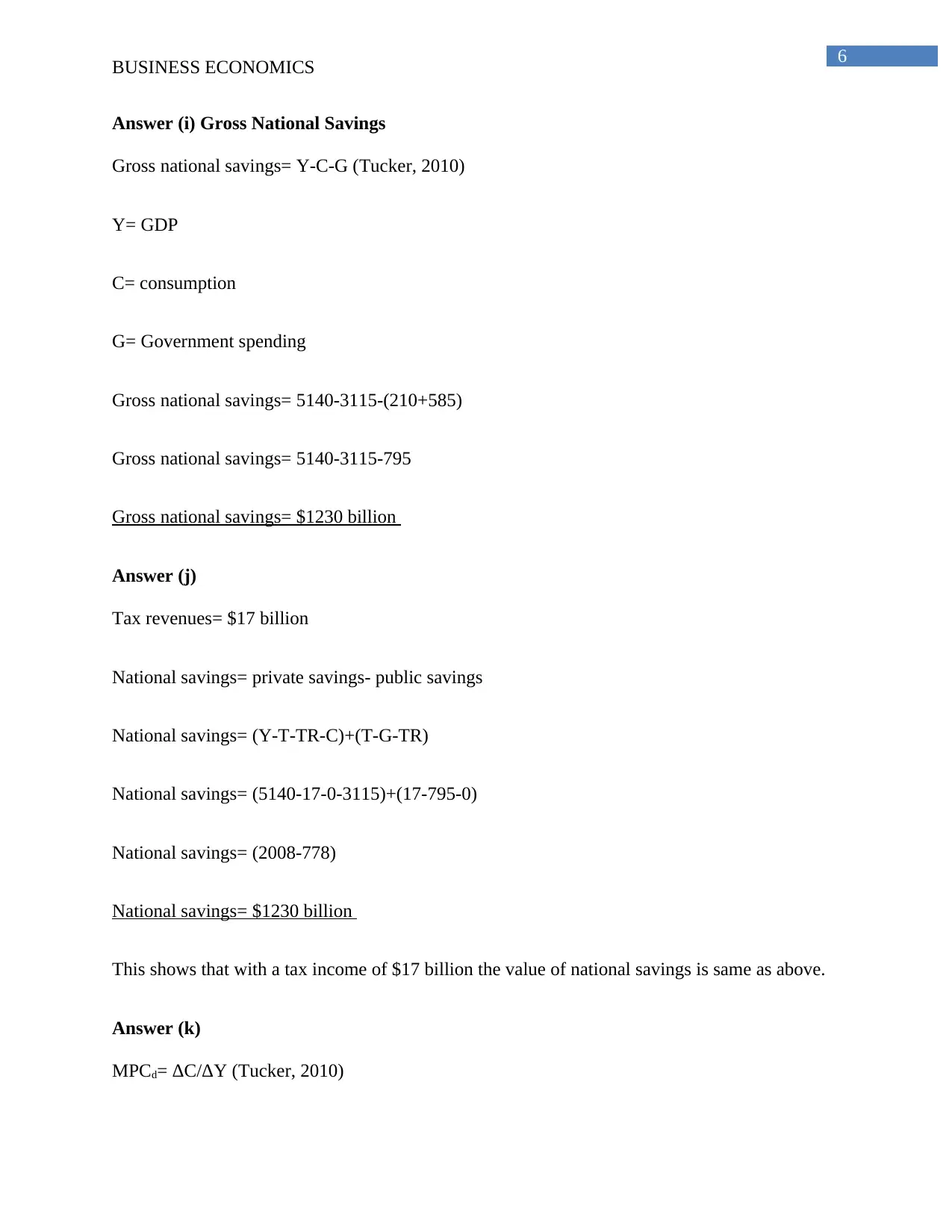
6
BUSINESS ECONOMICS
Answer (i) Gross National Savings
Gross national savings= Y-C-G (Tucker, 2010)
Y= GDP
C= consumption
G= Government spending
Gross national savings= 5140-3115-(210+585)
Gross national savings= 5140-3115-795
Gross national savings= $1230 billion
Answer (j)
Tax revenues= $17 billion
National savings= private savings- public savings
National savings= (Y-T-TR-C)+(T-G-TR)
National savings= (5140-17-0-3115)+(17-795-0)
National savings= (2008-778)
National savings= $1230 billion
This shows that with a tax income of $17 billion the value of national savings is same as above.
Answer (k)
MPCd= ΔC/ΔY (Tucker, 2010)
BUSINESS ECONOMICS
Answer (i) Gross National Savings
Gross national savings= Y-C-G (Tucker, 2010)
Y= GDP
C= consumption
G= Government spending
Gross national savings= 5140-3115-(210+585)
Gross national savings= 5140-3115-795
Gross national savings= $1230 billion
Answer (j)
Tax revenues= $17 billion
National savings= private savings- public savings
National savings= (Y-T-TR-C)+(T-G-TR)
National savings= (5140-17-0-3115)+(17-795-0)
National savings= (2008-778)
National savings= $1230 billion
This shows that with a tax income of $17 billion the value of national savings is same as above.
Answer (k)
MPCd= ΔC/ΔY (Tucker, 2010)
Paraphrase This Document
Need a fresh take? Get an instant paraphrase of this document with our AI Paraphraser
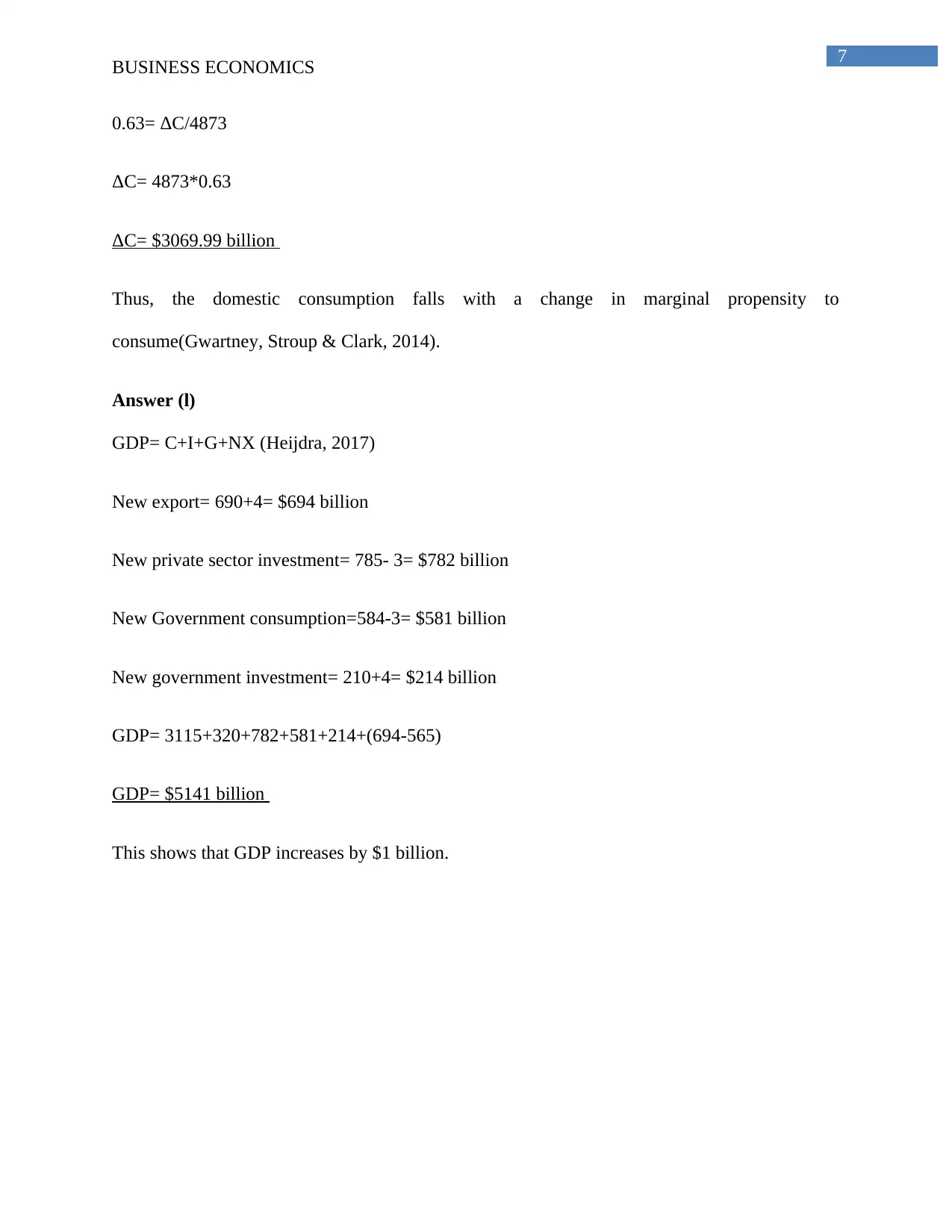
7
BUSINESS ECONOMICS
0.63= ΔC/4873
ΔC= 4873*0.63
ΔC= $3069.99 billion
Thus, the domestic consumption falls with a change in marginal propensity to
consume(Gwartney, Stroup & Clark, 2014).
Answer (l)
GDP= C+I+G+NX (Heijdra, 2017)
New export= 690+4= $694 billion
New private sector investment= 785- 3= $782 billion
New Government consumption=584-3= $581 billion
New government investment= 210+4= $214 billion
GDP= 3115+320+782+581+214+(694-565)
GDP= $5141 billion
This shows that GDP increases by $1 billion.
BUSINESS ECONOMICS
0.63= ΔC/4873
ΔC= 4873*0.63
ΔC= $3069.99 billion
Thus, the domestic consumption falls with a change in marginal propensity to
consume(Gwartney, Stroup & Clark, 2014).
Answer (l)
GDP= C+I+G+NX (Heijdra, 2017)
New export= 690+4= $694 billion
New private sector investment= 785- 3= $782 billion
New Government consumption=584-3= $581 billion
New government investment= 210+4= $214 billion
GDP= 3115+320+782+581+214+(694-565)
GDP= $5141 billion
This shows that GDP increases by $1 billion.
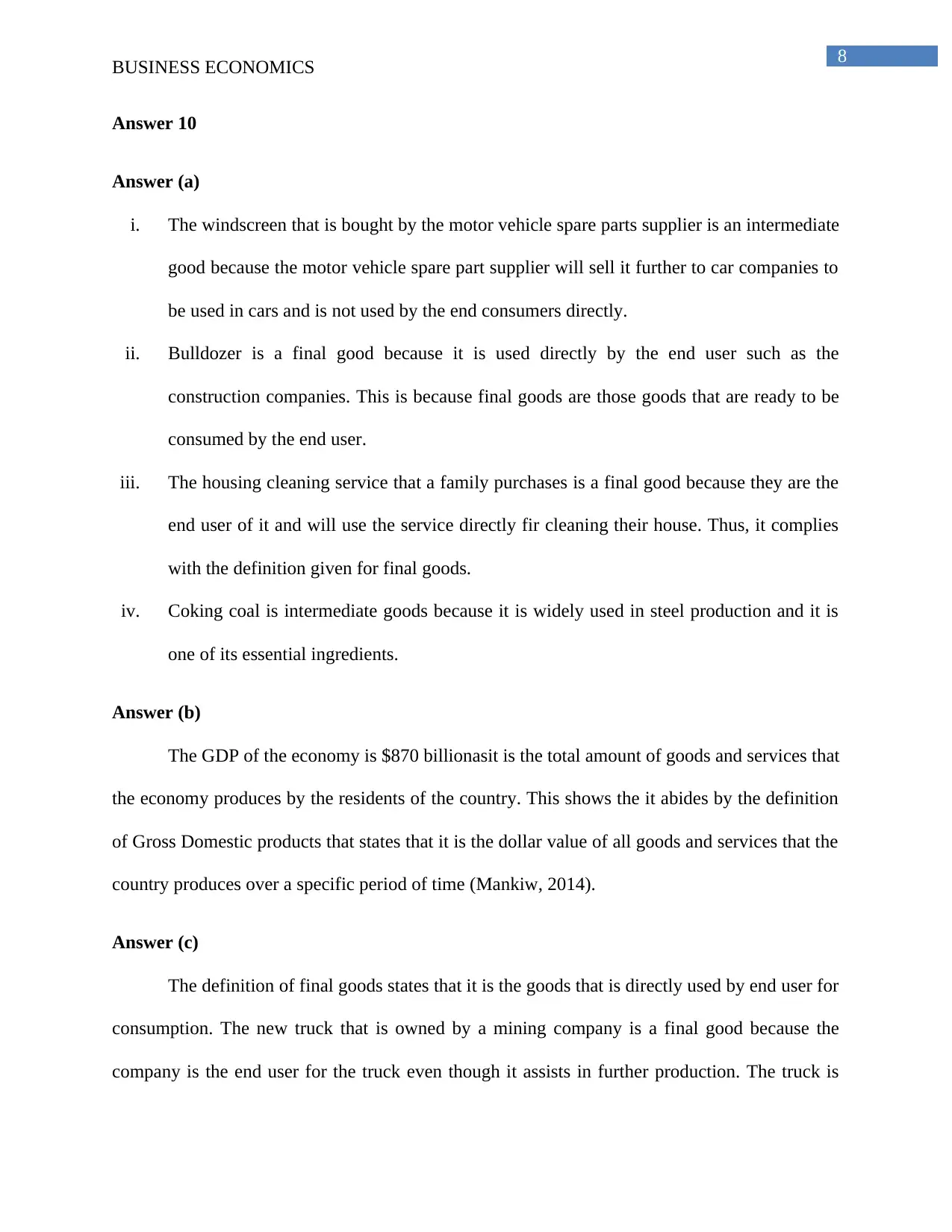
8
BUSINESS ECONOMICS
Answer 10
Answer (a)
i. The windscreen that is bought by the motor vehicle spare parts supplier is an intermediate
good because the motor vehicle spare part supplier will sell it further to car companies to
be used in cars and is not used by the end consumers directly.
ii. Bulldozer is a final good because it is used directly by the end user such as the
construction companies. This is because final goods are those goods that are ready to be
consumed by the end user.
iii. The housing cleaning service that a family purchases is a final good because they are the
end user of it and will use the service directly fir cleaning their house. Thus, it complies
with the definition given for final goods.
iv. Coking coal is intermediate goods because it is widely used in steel production and it is
one of its essential ingredients.
Answer (b)
The GDP of the economy is $870 billionasit is the total amount of goods and services that
the economy produces by the residents of the country. This shows the it abides by the definition
of Gross Domestic products that states that it is the dollar value of all goods and services that the
country produces over a specific period of time (Mankiw, 2014).
Answer (c)
The definition of final goods states that it is the goods that is directly used by end user for
consumption. The new truck that is owned by a mining company is a final good because the
company is the end user for the truck even though it assists in further production. The truck is
BUSINESS ECONOMICS
Answer 10
Answer (a)
i. The windscreen that is bought by the motor vehicle spare parts supplier is an intermediate
good because the motor vehicle spare part supplier will sell it further to car companies to
be used in cars and is not used by the end consumers directly.
ii. Bulldozer is a final good because it is used directly by the end user such as the
construction companies. This is because final goods are those goods that are ready to be
consumed by the end user.
iii. The housing cleaning service that a family purchases is a final good because they are the
end user of it and will use the service directly fir cleaning their house. Thus, it complies
with the definition given for final goods.
iv. Coking coal is intermediate goods because it is widely used in steel production and it is
one of its essential ingredients.
Answer (b)
The GDP of the economy is $870 billionasit is the total amount of goods and services that
the economy produces by the residents of the country. This shows the it abides by the definition
of Gross Domestic products that states that it is the dollar value of all goods and services that the
country produces over a specific period of time (Mankiw, 2014).
Answer (c)
The definition of final goods states that it is the goods that is directly used by end user for
consumption. The new truck that is owned by a mining company is a final good because the
company is the end user for the truck even though it assists in further production. The truck is
⊘ This is a preview!⊘
Do you want full access?
Subscribe today to unlock all pages.

Trusted by 1+ million students worldwide
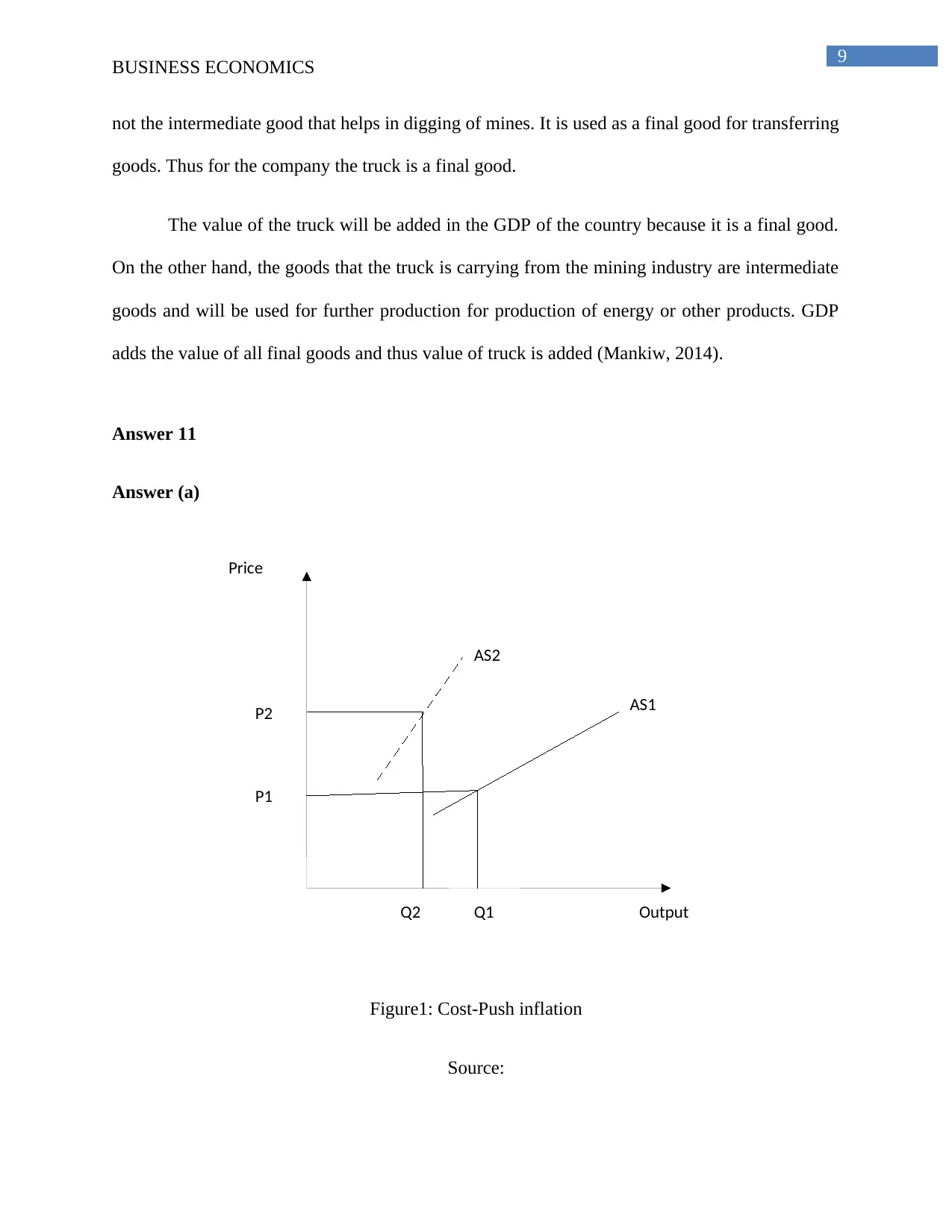
9
P2
P1
AS2
AS1
Q2 Q1
Price
Output
BUSINESS ECONOMICS
not the intermediate good that helps in digging of mines. It is used as a final good for transferring
goods. Thus for the company the truck is a final good.
The value of the truck will be added in the GDP of the country because it is a final good.
On the other hand, the goods that the truck is carrying from the mining industry are intermediate
goods and will be used for further production for production of energy or other products. GDP
adds the value of all final goods and thus value of truck is added (Mankiw, 2014).
Answer 11
Answer (a)
Figure1: Cost-Push inflation
Source:
P2
P1
AS2
AS1
Q2 Q1
Price
Output
BUSINESS ECONOMICS
not the intermediate good that helps in digging of mines. It is used as a final good for transferring
goods. Thus for the company the truck is a final good.
The value of the truck will be added in the GDP of the country because it is a final good.
On the other hand, the goods that the truck is carrying from the mining industry are intermediate
goods and will be used for further production for production of energy or other products. GDP
adds the value of all final goods and thus value of truck is added (Mankiw, 2014).
Answer 11
Answer (a)
Figure1: Cost-Push inflation
Source:
Paraphrase This Document
Need a fresh take? Get an instant paraphrase of this document with our AI Paraphraser
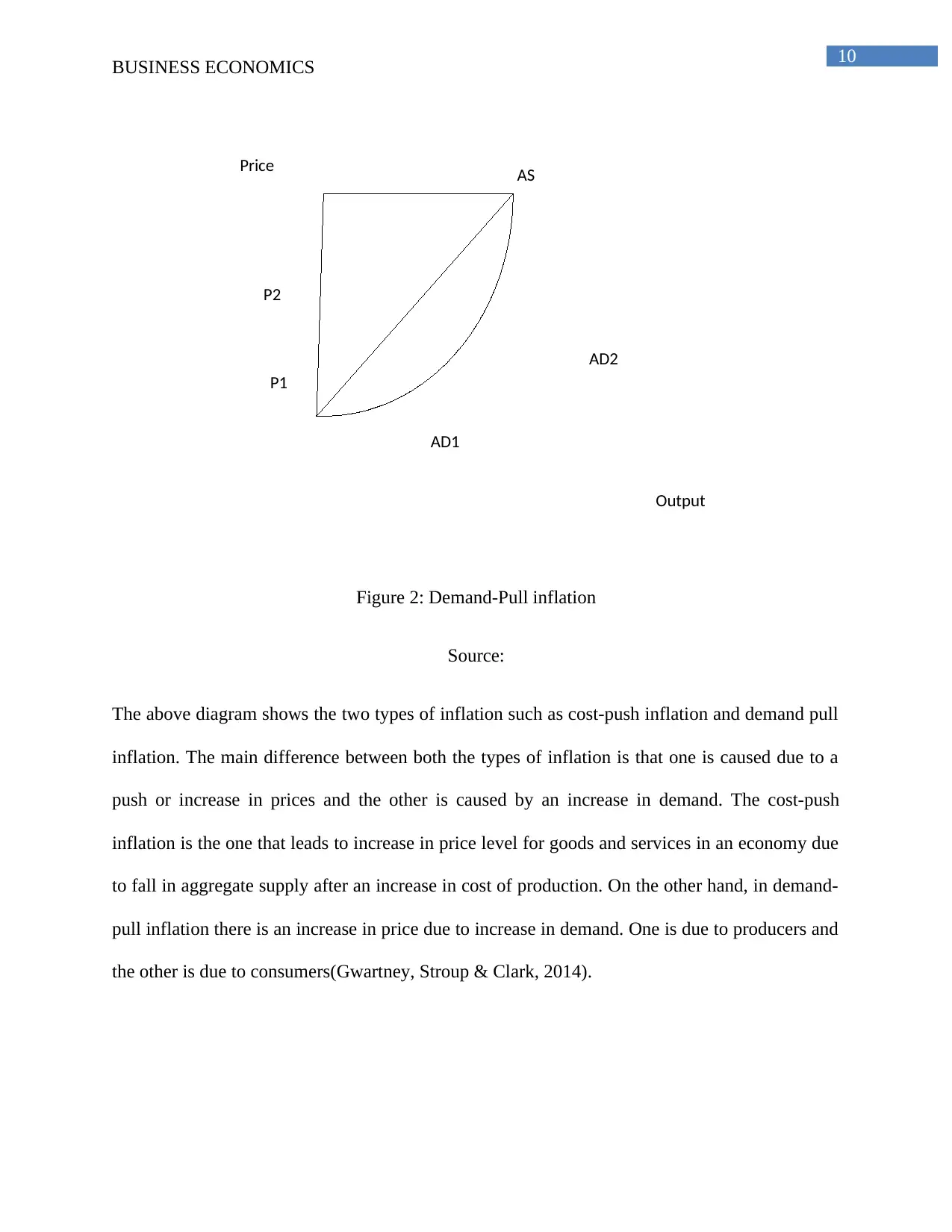
10
AS
AD1
Price
Output
AD2
P1
P2
BUSINESS ECONOMICS
Figure 2: Demand-Pull inflation
Source:
The above diagram shows the two types of inflation such as cost-push inflation and demand pull
inflation. The main difference between both the types of inflation is that one is caused due to a
push or increase in prices and the other is caused by an increase in demand. The cost-push
inflation is the one that leads to increase in price level for goods and services in an economy due
to fall in aggregate supply after an increase in cost of production. On the other hand, in demand-
pull inflation there is an increase in price due to increase in demand. One is due to producers and
the other is due to consumers(Gwartney, Stroup & Clark, 2014).
AS
AD1
Price
Output
AD2
P1
P2
BUSINESS ECONOMICS
Figure 2: Demand-Pull inflation
Source:
The above diagram shows the two types of inflation such as cost-push inflation and demand pull
inflation. The main difference between both the types of inflation is that one is caused due to a
push or increase in prices and the other is caused by an increase in demand. The cost-push
inflation is the one that leads to increase in price level for goods and services in an economy due
to fall in aggregate supply after an increase in cost of production. On the other hand, in demand-
pull inflation there is an increase in price due to increase in demand. One is due to producers and
the other is due to consumers(Gwartney, Stroup & Clark, 2014).
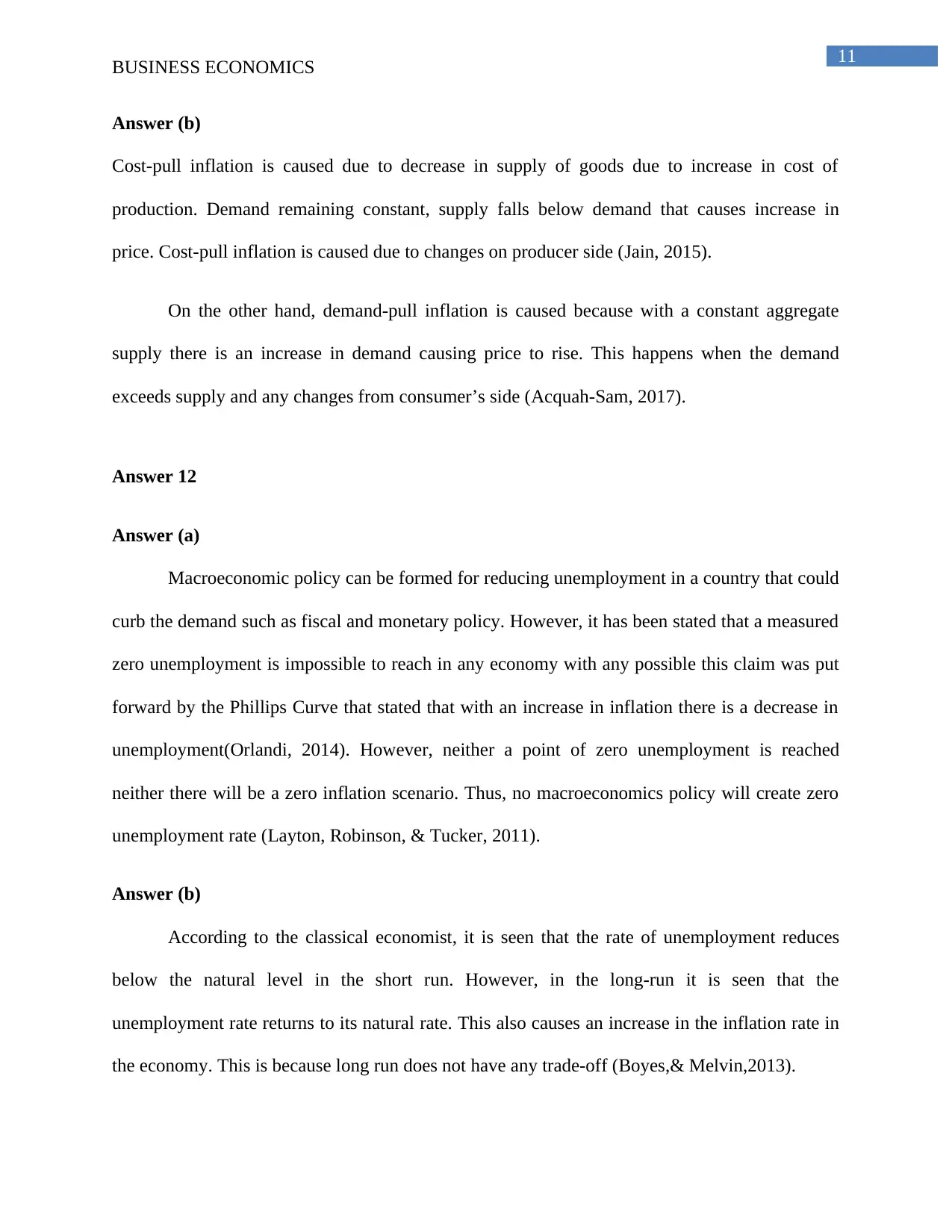
11
BUSINESS ECONOMICS
Answer (b)
Cost-pull inflation is caused due to decrease in supply of goods due to increase in cost of
production. Demand remaining constant, supply falls below demand that causes increase in
price. Cost-pull inflation is caused due to changes on producer side (Jain, 2015).
On the other hand, demand-pull inflation is caused because with a constant aggregate
supply there is an increase in demand causing price to rise. This happens when the demand
exceeds supply and any changes from consumer’s side (Acquah-Sam, 2017).
Answer 12
Answer (a)
Macroeconomic policy can be formed for reducing unemployment in a country that could
curb the demand such as fiscal and monetary policy. However, it has been stated that a measured
zero unemployment is impossible to reach in any economy with any possible this claim was put
forward by the Phillips Curve that stated that with an increase in inflation there is a decrease in
unemployment(Orlandi, 2014). However, neither a point of zero unemployment is reached
neither there will be a zero inflation scenario. Thus, no macroeconomics policy will create zero
unemployment rate (Layton, Robinson, & Tucker, 2011).
Answer (b)
According to the classical economist, it is seen that the rate of unemployment reduces
below the natural level in the short run. However, in the long-run it is seen that the
unemployment rate returns to its natural rate. This also causes an increase in the inflation rate in
the economy. This is because long run does not have any trade-off (Boyes,& Melvin,2013).
BUSINESS ECONOMICS
Answer (b)
Cost-pull inflation is caused due to decrease in supply of goods due to increase in cost of
production. Demand remaining constant, supply falls below demand that causes increase in
price. Cost-pull inflation is caused due to changes on producer side (Jain, 2015).
On the other hand, demand-pull inflation is caused because with a constant aggregate
supply there is an increase in demand causing price to rise. This happens when the demand
exceeds supply and any changes from consumer’s side (Acquah-Sam, 2017).
Answer 12
Answer (a)
Macroeconomic policy can be formed for reducing unemployment in a country that could
curb the demand such as fiscal and monetary policy. However, it has been stated that a measured
zero unemployment is impossible to reach in any economy with any possible this claim was put
forward by the Phillips Curve that stated that with an increase in inflation there is a decrease in
unemployment(Orlandi, 2014). However, neither a point of zero unemployment is reached
neither there will be a zero inflation scenario. Thus, no macroeconomics policy will create zero
unemployment rate (Layton, Robinson, & Tucker, 2011).
Answer (b)
According to the classical economist, it is seen that the rate of unemployment reduces
below the natural level in the short run. However, in the long-run it is seen that the
unemployment rate returns to its natural rate. This also causes an increase in the inflation rate in
the economy. This is because long run does not have any trade-off (Boyes,& Melvin,2013).
⊘ This is a preview!⊘
Do you want full access?
Subscribe today to unlock all pages.

Trusted by 1+ million students worldwide
1 out of 22
Related Documents
Your All-in-One AI-Powered Toolkit for Academic Success.
+13062052269
info@desklib.com
Available 24*7 on WhatsApp / Email
![[object Object]](/_next/static/media/star-bottom.7253800d.svg)
Unlock your academic potential
Copyright © 2020–2025 A2Z Services. All Rights Reserved. Developed and managed by ZUCOL.




